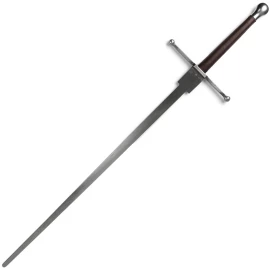Fencing Feder, two-handed training sword Nathaniel
This replica of a 15th century practice sword is equipped with a very narrow blade with a large ricasso, which makes this sword very easy to handle. The light crossguard with its rectangular cross-section is slightly curved towards the blade. The handle core is a continuous blade tang lined with wood. The outer layer of the hilt consists of a 5 mm thick, round cowhide strap coloured with black stain and treated with a moisture-repellent solution. A pear-shaped steel pommel closes the handle and balances the sword. More information...
Notify me when the item is in stock.
We will inform you as soon as we stock up.
Fencing Feder, two-handed training sword Nathaniel
The blade is made of spring steel 54SiCr6. The steel is oil-quenched and tempered to a hardness of 54-56 HRC degrees. Blades made of this steel are very tough (resistant to breakage) and flexible at the same time.
Source: Gerald Weland, Edged Weapons (1994), ISBN 13: 9783613015753
- Total length 130 cm
- Blade length 95.5 cm
- Handle length 26 cm
- Length of the pommel 7.3 cm
- Diameter of the pommel 39.41 mm
- Length of the crossguard 28 cm
- Blade width under the large ricasso 25.19 mm
- Blade width 10 cm off the blade point 17.75 mm
- The length of the large ricasso 10.9 cm
- Thickness of the blade edge 1.97 mm
- The point of balance POB lies 7 cm off the crossguard
- Weight 1383g
Due to the handcrafted nature of production, the above data may vary slightly from specimen to specimen.
The Feder, is a type of blunt and flexible training sword used in Fechtschulen (fencing schools) of the German Renaissance. The type has existed since at least the 15th century, but it came to be widely used as a standard training weapon only in the 16th century (when longsword fencing had ceased to have a serious aspect of duelling, as duels were now fought with the rapier), shown extensively in the fighting manuals of the time, particularly those of Paulus Hector Mair and Joachim Meyer, and it remained in use in such Fechtschulen well into the 17th, and in some cases for much of the 18th century. The Feder is somewhat lighter and narrower than a longsword and has a large ricasso (parrying hook) in front of the crossguard to protect the fencer´s fingers.
We are here for you



.2723751116.1709142138.JPG.webp)
.2723751116.1709142138.JPG.webp)
.2723751116.1709142138.JPG.webp)
.2723751116.1709142138.JPG.webp)
.2723751116.1709142138.JPG.webp)






